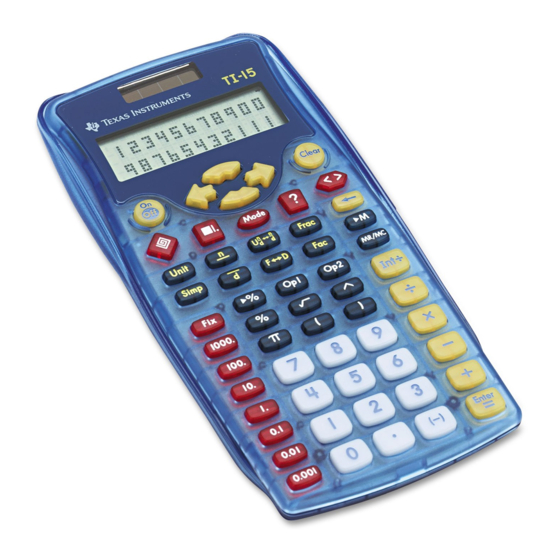Table of Contents
Advertisement
TI-15 Explorer
TI-15 Explorer ™ is a trademark of Texas Instruments
TM
Support Book
Chapter Name
I.
Display, scrolling up and
down, order of operations
and using brackets.
II.
I.
Calculator
II.
III.
Fraction
exponents (powers) and square root
14. Copyright information
1
Page
2
3
6
7
9
12
13
14
16
17
19
19
20
21
Advertisement
Table of Contents

Summary of Contents for Texas Instruments TI-15 Explorer
-
Page 1: Table Of Contents
6. Percent 7. Constant operations 8. Problem solving in Auto mode 9. Problem solving in Manual mode 10. Place value 11. Memory 12. Error messages 13. Display indicators 14. Copyright information TI-15 Explorer ™ is a trademark of Texas Instruments... -
Page 2: Introduction To The Display
1. Introduction to the Display a. Using your thumbs, press and hold down both and at the same time, then release both keys at the same time. MEM CLEARED is displayed. This RESETS the calculator to its default settings. b. -
Page 3: Mode Menus
will clear the last digit entered so that you do not need to re-enter an entire number. Pressing and simultaneously resets settings to defaults and clears memory and constants. 2. Mode menus See worksheets for further explanations and uses. a. -
Page 4: Problem Solving
b. Problem solving mode Press to enter problem solving and with to set. To exit problem solving press and the small icon will disappear from the screen. In MAN (manual mode) you can enter your own problem – eg ? x ? = 36, and the calculator shows that this has 9 solutions –... - Page 5 c. Fractions menu Press and to choose then to set. See fractions section below.
-
Page 6: Basic Operations Including
3. Basic operations, including exponent (powers) and square roots a. These are the usual operations with , , , and , except that the result of a division depends on which mode is set for This screen is accessed by pressing ... -
Page 7: Whole Numbers And Decimals
Whole numbers and decimals a. The key sets the number of decimal places together with the appropriate RED Place Value key from the left hand side of the calculator. The rounded result is displayed but the original number is retained in the memory. ... - Page 8 c. Three Results of Division There are three different ways that a division can be displayed on the screen. Decimal answer (i) Quotient and remainder answer (ii) Fraction answer (iii) Key in Decimal answer is displayed.
-
Page 9: Fractions
5. Fractions a. displays a menu from which the way a fraction is shown is set Un/d displays a mixed number and n/d displays a single fraction (improper fraction) result. and whether any given fraction is unsimplified (Man) with showing at the top, or in simplest terms with Auto ... - Page 10 g. Stacked fractions, Entering mixed numbers, numerators, and denominators . Key in is displayed. You can enter either the numerator or denominator first. Fractions are stacked. You can see the whole problem and the answer at the same time. h.
- Page 11 To summarise different fraction forms: Dividing a fraction by a fraction gives fractional results regardless of the division setting (decimal or fraction). The mode settings provide 4 possible display options for computational results displayed in fraction form. For example, for 6 ÷ 4, the displays would look like this: MANual simp/improper (n/d) : AUTO simp/improper (n/d) : ��...
-
Page 12: Percent
Percent a. enters % after a number. Pressing changes the % to a decimal Pressing and will change the display from decimal to fraction and then to percent. b. Press to see 0.25 change to 25%. Pressing changes the ... -
Page 13: Constant Operations
iii. Press to start the constant operation. The “expression” 0 + 5 is displayed on the top line. The 1 on the bottom line is the number of times the operation has been performed. The 5 on the bottom line is the result. iv. -
Page 14: Problem Solving In Auto Mode
8. Problem solving in Auto mode a. Press the key to enter Problem Solving. and indicators are displayed, indicating that you are Auto in the Automatic mode of Problem Solving. A simple equation with one part missing is automatically displayed. - Page 15 g. Press Down again. The selection is displayed. This selects the type of problems displayed; addition, subtraction, multiplication, or division, or a ? in place of the operation symbol so you have to choose the operation. Press and ...
-
Page 16: Problem Solving In Manual Mode
9. Problem solving in Manual mode Manual problem solving a. If you are not already in Problem Solving, press the key to enter Problem Solving. indicators are displayed, along with a randomly generated problem. Auto b. Press to enter the Problem Solving menu. -
Page 17: Place Value
10. Place value Overview To use place value you must: be in Problem Solving MANUAL mode. enter the number before you press the key. 1. If you are not already in Problem Solving, press the key to enter Problem Solving. - Page 18 How many hundreds, tenths, ones (2 ways) Enter a number such as 7896.453. Press . and are displayed. You are now in the Place Value part of Problem Solving Mode. Press . _ 8 _ _. _ _ _, and then 8 -> 100 is displayed. The 8 is in the hundreds place.
-
Page 19: Memory
11. Memory 1. There are two memory keys and . M is displayed on the screen if a value other than zero is in memory. will recall whatever is in memory. To clear the memory, press twice. ... -
Page 20: Display Indicators
13. Display Indicators...















